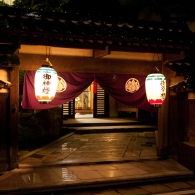
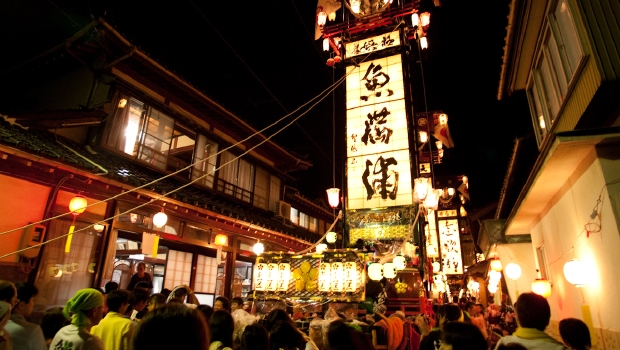


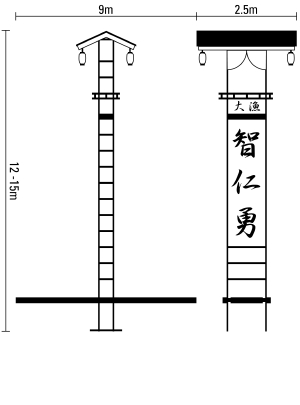
By SHIZUO / Published: June 17, 2011
100 people drag one of the tallest Kiriko lantern floats!
The Kiriko is a uniquely designed lantern float found in the Noto Peninsula. The Abare Matsuri festival in Noto Town, Nafune Taisai in Wajima City, and Iida Toroyama Matsuri in Suzu City also have tall lanterns which are similar in style. Although it's not well-recorded in history, it seems that the first Kiriko lantern was small enough for one person to carry. Then, people started to compete with others in the different districts for the size! Fishermen are quite religious because their occupation can be fatal. They spend money and provide offerings for the God of the ocean and to show their enthusiasm.
The Issaki Hoh-toh-Matsuri is well-know for having the tallest Kiriko in the Noto Peninsula. They have 6-7 Kiriko which are 12-15 meters in height and weight about two tons each. Issaki is somewhat of a slang word for the district name, Ishizaki. So if you go there to see the festival, you should use "Issaki" instead of the official name, you'll sound like a pro!
Issaki Hoh-toh Matsuri Festival
Place: Ishizaki district, Nanao City
Date: The first Saturday of August
How to get to Ishizaki District: Take a JR "Nanao Line" train, get off at "Wakura-Onsen Station"! Check the timetable!
The three Kanji characters mean, "a bay full of fishes", "wisdom, affection and braveness", etc...

This festival was originally a Noh-ryo-Sai (festival to enjoy the cool breeze of the evening) at Ishizaki Hachiman-Jinja shrine, but there were no Kiriko floats at that time. It's said that after several great fires, a fishing net maker introduced the huge lanterns from the northern area of Noto in 1889. In other words, the festival is not so old. Also, most of the Kiriko festivals in the peninsula are descended from the Gion Matsuri festival in Kyoto. The Issaki Hoh-Toh Matsuri was no exception. It was held on the 15th of June until 1995, so that is a very important day for the Gion-Sha shrine.
Just so you know, Issaki's lanterns have Kanji (Chinese characters) on the front and pictures of warriors on the back. Nobody really knows why people choose the three Kanji used for each lantern, some have the meaning, "a bay full of fishes", others say, "wisdom, affection and braveness". Sound very fisherman-like, huh? Anyway, the Issaki district's Kiriko design uses what we call "Nobori-Bata-Type", which looks like a streamer. No wonder it's so unbalanced! Most of the Nobori-Bata-Type Kirikos are just 4-5 meters in height. Other districts in the peninsula are proud of the number of Kiriko they used, but they also put a lot of pride on the size of the floats. The Issaki district is completely opposite!
It's lovely they decorate their houses with small lanterns and Noren curtains, which have their family crests dyed!

The houses are designed so that the doors are opened toward the streets. On a festival day, you will see many people coming in and out of houses, drinking Sake on Tatami mats, and cheering the people dragging the huge lanterns. It's as if everyone in the district is family. They decorate their houses with small lanterns and Noren curtains with their family crests embroidered. Lovely, isn't it? You'll wish that you were one of the residents on the day of the festival.
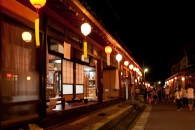
They all slightly jump and shout "Sorei!" when starting to walk.
"Sakka-sai! Saka-sassai! Isasaka-sah!"
Six or seven Kiriko start to move to the Doh-no-mae Hiroba plaza, showing you a performance before and after sunset. The Daytime performance under the blue sky is powerful, and the nighttime performance is like a fantasy with all of the lantern lights visable.

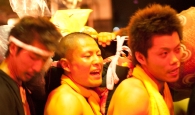
The night performance goes on until midnight. Even when the festival is finally over, the sounds of the exotic bell will still ring in your ears.
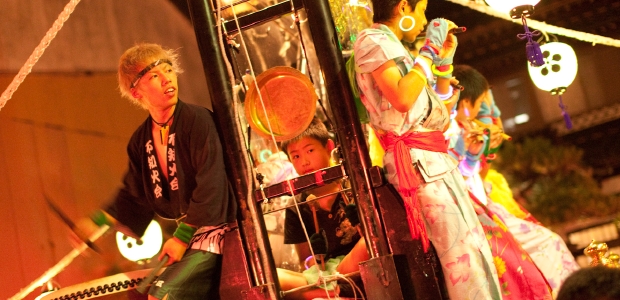
Kanazawa Area
Kenroku-En Garden
Seisonkaku Villa
Kanazawa-Jo Castle
Hishi-Yagura/<br>Gojikken-Nagaya/<br>Hashizume-Mon Tsuzuki-Yagura Museum
Chaya-Gai<br>Geisha Districts
Nagamachi Buke-Yashiki-Ato (Previous Samurai District)
21st Century Museum of<br> Contemporary Art, <br>Kanazawa
Nomura-Ke<br>Samurai House
Yuwaku Onsen-Kyo Spa Village
Kanazawa Yuwaku Edo-Mura Museum
Following Matsuo Bashô’s steps in Ishikawa - 1/6 [Introduction]
Following Matsuo Bashô’s steps in Ishikawa - 2/6 [Kanazawa]
Light-Up Bus
Noto Area
Rokkosaki Cape
Mitsukejima Island
Day Trip from Kanazawa #01-Wakura-Onsen Spa Town Nanao City
Day Trip from Kanazawa #01-Ipponsugi Dohri Street Nanao City
Noto-Jima Glass Art Museum
Wajima Asaichi Morning Market
Sohjiji Soin Temple
Kaga Area
Komatsu Experience
Shirayama Hime-Jinja Shrine
Daishoji District
Kaga-Hashidate District
Higashitani Mountainous Area
Following Matsuo Bashô’s steps in Ishikawa - 3/6 [Komatsu City]
Following Matsuo Bashô’s steps in Ishikawa - 4/6 [Natadera Temple]
Following Matsuo Bashô’s steps in Ishikawa - 5/6 [Yamanaka Onsen Town]
Following Matsuo Bashô’s steps in Ishikawa - 6/6 [Daishoji District]
Rosanjin in Yamashiro Onsen Town
Hakusanroku Gibier: Local cuisine utilized wild game from the mountain area
Noto no Shio: Salt extracted from the sea
Jizake: Local sake in Hokuriku region
Buri: Yellowtail
Kaga-ryori:<br>The Traditional Local Food
Kanou-gani & Kobako snow crabs
Kaga Yasai:<br>Traditional Vegetables
Tempura
Sushi
Komatsu Udon Noodle
Event
Enyukai: Geisha Party
Geisha Performance with Dinner
Sunday Zazen Session
Custom
Shintoism
Arts and Crafts
Yamanaka Shikki: <br>Lacquer Ware made in Yamanaka
Wajima Nuri<br>Lacquerware
Wagasa<br>(Traditional Umbrella)
Kaga Temari<br>(Traditional Handball)
Kaga-Yubinuki<br>(Traditional Thimble)
Kutani-Yaki<br>Porcelain
Aochibu Blue Dot(br)Kutani Artist - Kingyoku Nakata
Kaga Hachiman Okiagari<br> Paper Doll
Kaga Kebari<br>Feather Bait
Stroll Kanazawa in Rental Kimono - 1/2 [Renting kimono]
Stroll Kanazawa in Rental Kimono - 2/2 [Strolling in Kimono]
January
Dezomeshiki<br>Firefighters' Ceremony
Enyukai: Geisha Party
February
Setsubun-Sai Festival
Yukidaruma Matsuri<br>
Festival
April
Enyukai: Geisha Party
Sakura Viewing
May
Seihakusai Festival
Kutani Chawan Matsuri
(Outdoor Market)
Otabi Matsuri Festival
Okaeri Matsuri Festival
June
Hyakumangoku Matsuri<br>Festival
July
Enyukai: Geisha Party
Abarei Matsuri Festival
Yamashiro Daidengaku Dance Festival
August
Issaki Hoh-toh Matsuri Festival
Niwaka Matsuri Festival
November
Kanou-gani & Kobako snow crabs
Enyukai: Geisha Party
December
Enyukai: Geisha Party
All Year Round
Wajima Asaichi Morning Market
Sunday Zazen Session
Light-Up Bus
Shops
Stroll Kanazawa in Rental Kimono - 1/2 [Renting kimono]
Stroll Kanazawa in Rental Kimono - 2/2 [Strolling in Kimono]
Sunday Zazen-Session
Paragliding
Snowboarding
Pottery-Making
Kanazawa Smoking<br>Etiquette Guide
Special Interview<br>after the Tohoku Earthquake
Tourist Centers
About Ishikawa Prefecture
How to Get to Kanazawa
Access from Tokyo
Access from Osaka
Access from Nagoya
Access from Takayama
How to Get to the Noto Peninsula
About Us


